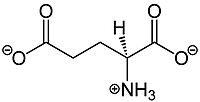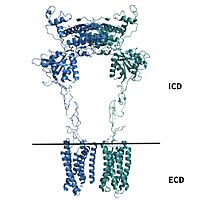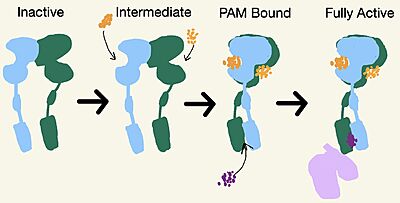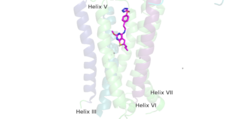Sandbox Reserved 1703
From Proteopedia
(Difference between revisions)
| Line 4: | Line 4: | ||
==Introduction== | ==Introduction== | ||
| - | '''Metabotropic glutamate receptors''' are found in the central nervous system and play a critical role in modulating cell excitability and synaptic transmission <ref name="Lin">PMID: 34135510</ref>.[https://en.wikipedia.org/wiki/Glutamate_(neurotransmitter) Glutamate], shown in Figure 1, is a negatively charged polar amino acid that is the main neurotransmitter in the brain. Glutamate activates 8 different types of metabotropic glutamate receptors<ref name="Seven">Seven, Alpay B., et al. “G-Protein Activation by a Metabotropic Glutamate Receptor.” Nature News, Nature Publishing Group, 30 June 2021, https://www.nature.com/articles/s1586-021-03680-3</ref>. '''Metabotropic Glutamate Receptor 2 (mGlu2)''' is a member of the [https://en.wikipedia.org/wiki/Class_C_GPCR Class C GPCR]Family and can further be classified into the Group II subgroup of metabotropic receptors. Since mGlu2 is a part of the Class C GPCR family, it undergoes small conformational changes to the transmembrane domain (TMD) to move from the inactive to the fully active structure. Class A and B GPCR Families, however, have a different mechanism that causes conformational changes to Transmembrane 6<ref name="Seven" />. mGlu2 functionality is dependent on the concentration of glutamate where higher concentrations of glutamate will promote stronger signal transduction from the extracellular domain to the transmembrane domain<ref name="Lin" />. [[Image:320px-L-Glutamate Structural Formulae.jpg|200px|right|thumb|'''Figure 1.''' | + | '''Metabotropic glutamate receptors''' are found in the central nervous system and play a critical role in modulating cell excitability and synaptic transmission <ref name="Lin">PMID: 34135510</ref>.[https://en.wikipedia.org/wiki/Glutamate_(neurotransmitter) Glutamate], shown in Figure 1, is a negatively charged polar amino acid that is the main neurotransmitter in the brain. Glutamate activates 8 different types of metabotropic glutamate receptors<ref name="Seven">Seven, Alpay B., et al. “G-Protein Activation by a Metabotropic Glutamate Receptor.” Nature News, Nature Publishing Group, 30 June 2021, https://www.nature.com/articles/s1586-021-03680-3</ref>. '''Metabotropic Glutamate Receptor 2 (mGlu2)''' is a member of the [https://en.wikipedia.org/wiki/Class_C_GPCR Class C GPCR]Family and can further be classified into the Group II subgroup of metabotropic receptors. Since mGlu2 is a part of the Class C GPCR family, it undergoes small conformational changes to the transmembrane domain (TMD) to move from the inactive to the fully active structure. Class A and B GPCR Families, however, have a different mechanism that causes conformational changes to Transmembrane 6<ref name="Seven" />. mGlu2 functionality is dependent on the concentration of glutamate where higher concentrations of glutamate will promote stronger signal transduction from the extracellular domain to the transmembrane domain<ref name="Lin" />. [[Image:320px-L-Glutamate Structural Formulae.jpg|200px|right|thumb|'''Figure 1.'''Structure of glutamate. Glutamate binding promotes stronger signal transduction to aid in g-protein activation by mGlu2.]] |
mGlu2 plays vital roles in memory formation, pain management, and addiction, which makes it an important drug target for [https://en.wikipedia.org/wiki/Parkinson%27s_disease Parkinson’s Disease],[https://en.wikipedia.org/wiki/Schizophrenia Schizophrenia], [https://en.wikipedia.org/wiki/Cocaine_dependence cocaine dependence], and many other neurological conditions. | mGlu2 plays vital roles in memory formation, pain management, and addiction, which makes it an important drug target for [https://en.wikipedia.org/wiki/Parkinson%27s_disease Parkinson’s Disease],[https://en.wikipedia.org/wiki/Schizophrenia Schizophrenia], [https://en.wikipedia.org/wiki/Cocaine_dependence cocaine dependence], and many other neurological conditions. | ||
| Line 27: | Line 27: | ||
A positive allosteric modulator (PAM) or a negative allosteric modulator (NAM) can bind to mGlu2. PAM and NAM induce different conformational changes, which result in different outcomes. <scene name='90/904308/Pam/3'>PAM binds</scene> to the receptor, induces conformational changes, which helps to promote greater affinity for G protein binding. PAM binds in a binding pocket that is created by helices III, V, VI, VII in the TMD. Within helix VI, the hydrophobic is is composed of W773, F776, L777, and F780. Due to spatial hindrance, helix VI is shifted downward, causing conformational changes. NAM, however, reduces the affinity for G protein binding. NAM binds to the same binding pocket as PAM and also interacts with residue W773, but NAM occupies the binding site a little deeper than PAM. This causes NAM to push the side chain of W773 towards helix VII<ref name="Lin"/>. | A positive allosteric modulator (PAM) or a negative allosteric modulator (NAM) can bind to mGlu2. PAM and NAM induce different conformational changes, which result in different outcomes. <scene name='90/904308/Pam/3'>PAM binds</scene> to the receptor, induces conformational changes, which helps to promote greater affinity for G protein binding. PAM binds in a binding pocket that is created by helices III, V, VI, VII in the TMD. Within helix VI, the hydrophobic is is composed of W773, F776, L777, and F780. Due to spatial hindrance, helix VI is shifted downward, causing conformational changes. NAM, however, reduces the affinity for G protein binding. NAM binds to the same binding pocket as PAM and also interacts with residue W773, but NAM occupies the binding site a little deeper than PAM. This causes NAM to push the side chain of W773 towards helix VII<ref name="Lin"/>. | ||
| - | [[Image:PAM binding pocket correct.png |250px|right|thumb|'''Figure 4.''' | + | [[Image:PAM binding pocket correct.png |250px|right|thumb|'''Figure 4.'''PAM located binding pocket. PAM, JNJ-40411813, is shown in magenta and colored by atom type, four labelled binding helices (III, V, VI, and VII) create the binding pocket in the 7TM region for PAM binding. PAM binding promotes G-protein activation by mGLu2.]] |
===Active State=== | ===Active State=== | ||
| Line 33: | Line 33: | ||
====G-Protein Recognition==== | ====G-Protein Recognition==== | ||
| - | + | Transition to the active state also reorients helix lll in both monomers to enable binding to the G-protein: Yet only one chain is required for full receptor activation. The intracellular region of helix lll contributes the main interactions with the alpha subunit of the G-protein. Intracellular Loop 2 also builds a polar interaction network with the G-protein through its ionic interactions with the <scene name='90/904308/Binding_recognition_site/2'> α-subunit</scene> of the G-protein. Lastly, mGlu2 residue E666 forms a salt bridge with an alpha N residue (R32) on the α-subunit which further destabilizes the inactive conformation<ref name="Lin"/>. | |
====G-protein Binding==== | ====G-protein Binding==== | ||
Revision as of 23:36, 14 April 2022
Metabotropic Glutamate Receptor 2
| |||||||||||
References
- ↑ 1.0 1.1 1.2 1.3 1.4 1.5 1.6 1.7 1.8 Lin S, Han S, Cai X, Tan Q, Zhou K, Wang D, Wang X, Du J, Yi C, Chu X, Dai A, Zhou Y, Chen Y, Zhou Y, Liu H, Liu J, Yang D, Wang MW, Zhao Q, Wu B. Structures of Gi-bound metabotropic glutamate receptors mGlu2 and mGlu4. Nature. 2021 Jun;594(7864):583-588. doi: 10.1038/s41586-021-03495-2. Epub 2021, Jun 16. PMID:34135510 doi:http://dx.doi.org/10.1038/s41586-021-03495-2
- ↑ 2.0 2.1 Seven, Alpay B., et al. “G-Protein Activation by a Metabotropic Glutamate Receptor.” Nature News, Nature Publishing Group, 30 June 2021, https://www.nature.com/articles/s1586-021-03680-3
- ↑ Du, Juan, et al. “Structures of Human mglu2 and mglu7 Homo- and Heterodimers.” Nature News, Nature Publishing Group, 16 June 2021, https://www.nature.com/articles/s41586-021-03641-w.>
- ↑ 4.0 4.1 4.2 4.3 Muguruza C, Meana JJ, Callado LF. Group II Metabotropic Glutamate Receptors as Targets for Novel Antipsychotic Drugs. Front Pharmacol. 2016 May 20;7:130. doi: 10.3389/fphar.2016.00130. eCollection, 2016. PMID:27242534 doi:http://dx.doi.org/10.3389/fphar.2016.00130
- ↑ Ellaithy A, Younkin J, Gonzalez-Maeso J, Logothetis DE. Positive allosteric modulators of metabotropic glutamate 2 receptors in schizophrenia treatment. Trends Neurosci. 2015 Aug;38(8):506-16. doi: 10.1016/j.tins.2015.06.002. Epub, 2015 Jul 4. PMID:26148747 doi:http://dx.doi.org/10.1016/j.tins.2015.06.002
Student Contributors
Frannie Brewer and Ashley Wilkinson




